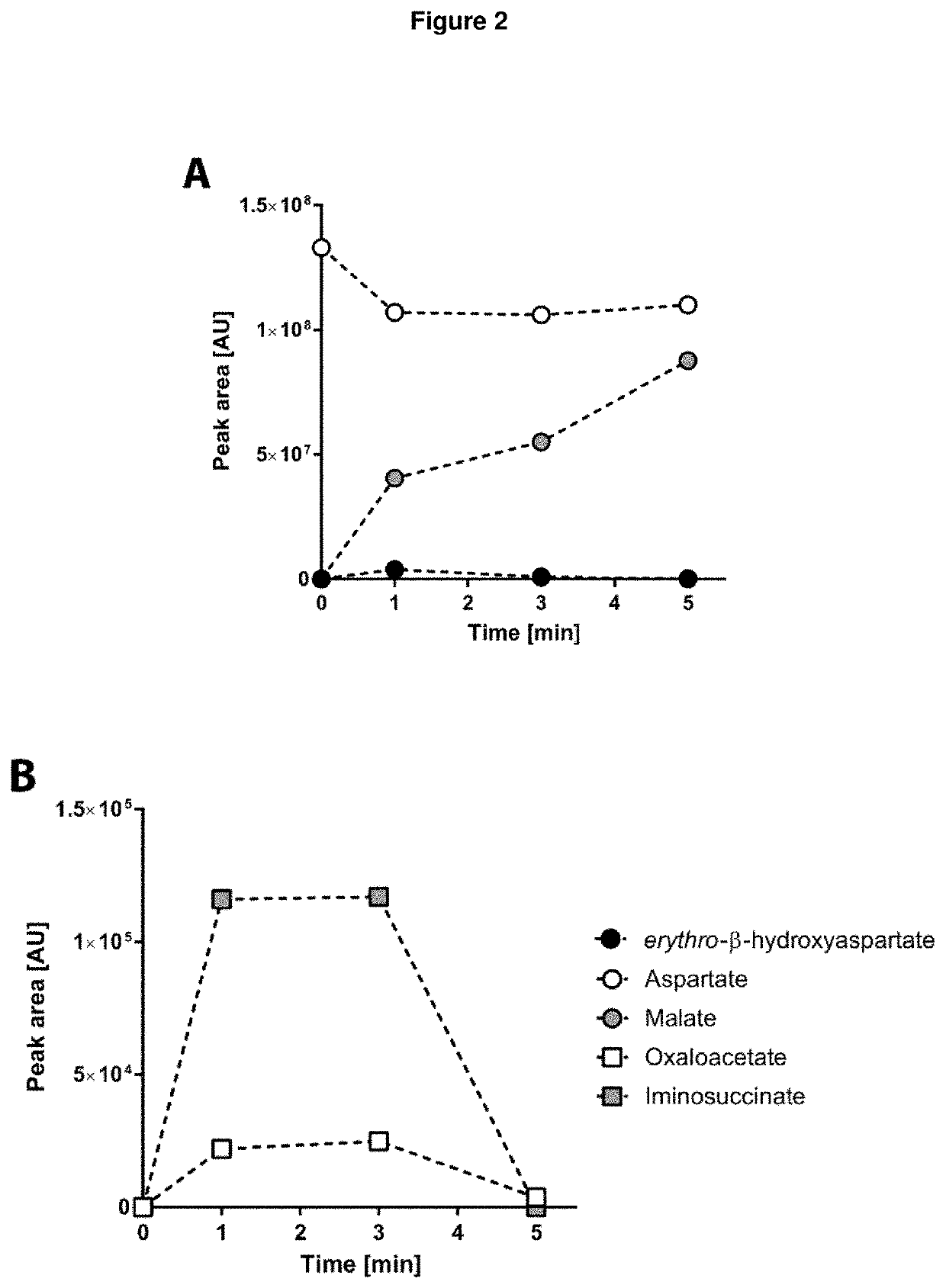A method for the production of plants with altered photorespiration and improved co2 fixation
a technology of photorespiration and co2 fixation, which is applied in the direction of lyase, biochemistry apparatus and processes, recombinant dna-technology, etc., can solve the problems of reducing productivity, no suitable method has been provided that leads to an improvement of growth, productivity and/or yield of agricultural crop plants, and komber and morris do not disclose which enzymes or genes. , to achieve the effect of increasing growth, productivity and/or yield
- Summary
- Abstract
- Description
- Claims
- Application Information
AI Technical Summary
Benefits of technology
Problems solved by technology
Method used
Image
Examples
example 1
haracterization of the Enzymes of the β-Hydroxyaspartate Pathway (BHAP) and Reconstruction of the BHAP In Vitro
[0708]The genes encoding for the four enzymes of the BHAP in the genome of Paracoccus denitrificans DSM 413 were identified and these four proteins were heterologously expressed in E. coli. The four enzymes were purified and subjected to kinetic characterization by conducting suitable enzyme assays. Kinetic parameters of the enzymes are summarized in Table 1. The complete reaction sequence of the BHAP, catalyzed by these four enzymes, is shown in FIG. 1.
[0709]To assess the efficiency of the BHAP in converting its input molecule (glyoxylate) into its output molecule (oxaloacetate), a combined assay of all four enzymes was conducted. Additionally, the enzymes malate dehydrogenase (MDH) and formate dehydrogenase (FDH) were added. MDH converts oxaloacetate into malate, which can be analyzed well via LC-MS, while FDH as cofactor regeneration system is required for the regenerati...
example 2
the β-Hydroxyaspartate Pathway (BHAP) for Implementation in Plant Peroxisomes
[0711]Initially, the β-hydroxyaspartate pathway (BHAP) from Paracoccus denitrificans DSM 413 has been implemented in plant peroxisomes due to high expected concentrations of photorespiration-derived glyoxylate (FIG. 1). The genes coding the four enzymes (aspartate-glyoxylate aminotransferase (AsGAT), β-hydroxyaspartate aldolase (BHAA), β-hydroxyaspartate dehydratase(BHAD) and iminosuccinate reductase (ISRed)) of the BHAP were codon-optimized for expression in Arabidopsis thaliana (henceforth: Arabidopsis) by gene synthesis (Sigma Aldrich, Germany). In order to target the BHAP enzymes to plant peroxisomes, synthetic fusions with peroxisomal targeting sequences were generated. AsGAT, BHAD and ISRed were C-terminally fused with the three amino acid peroxisomal targeting signal 1 (PTS1; serine-lysine-leucine). C-terminal fusion of BHAA with PTS1 inactivated the enzyme and therefore, BHAA was N-terminally fused ...
example 3
ting BHAP Enzyme Targeting to Plant Peroxisomes
[0712]The inventors were able to demonstrate the correct localization of BHAP enzymes in plant peroxisomes (FIG. 3). Peroxisomal targeting of BHAP enzymes was confirmed via co-localization studies in Nicotiana benthamiana (N. benthamiana). Fluorescent fusion constructs of BHAP enzymes were co-infiltrated with a peroxisomal organellar marker for transient expression in N. benthamiana and co-localization was confirmed by confocal microscopy with isolated N. benthamiana protoplasts (FIG. 3). AsGAT and BHAD were N-terminally fused with Dicosoma sp. red fluorescent protein (mCherry) (nucleic acid sequence and amino acid sequence: SEQ ID NOs 920 and 921, respectively). ISRED was N-terminally fused with an enhanced green fluorescent protein (eGFP) (nucleic acid sequence and amino acid sequence: SEQ ID NO 922 and 923, respectively) and BHAA was C-terminally fused with Dicosoma sp. red fluorescent mCherry. Used peroxisomal markers are either mCh...
PUM
| Property | Measurement | Unit |
|---|---|---|
| Fraction | aaaaa | aaaaa |
| Efficiency | aaaaa | aaaaa |
Abstract
Description
Claims
Application Information
 Login to View More
Login to View More - R&D
- Intellectual Property
- Life Sciences
- Materials
- Tech Scout
- Unparalleled Data Quality
- Higher Quality Content
- 60% Fewer Hallucinations
Browse by: Latest US Patents, China's latest patents, Technical Efficacy Thesaurus, Application Domain, Technology Topic, Popular Technical Reports.
© 2025 PatSnap. All rights reserved.Legal|Privacy policy|Modern Slavery Act Transparency Statement|Sitemap|About US| Contact US: help@patsnap.com



